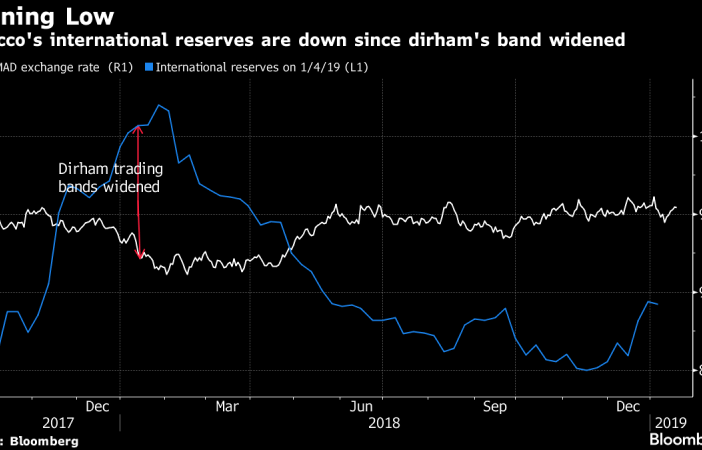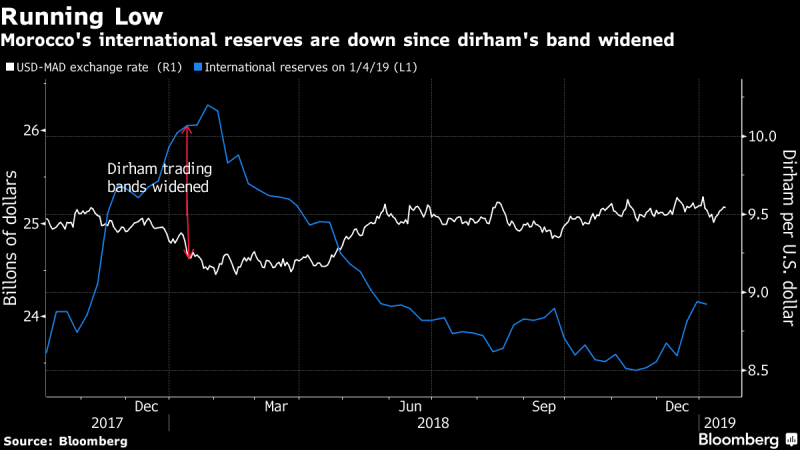Bloomberg
Economics
By Souhail Karam
> Further loosening of dirham fluctuation unlikely in 2019
> Focus on cutting fiscal gap as Gulf donations near drought
Morocco will take a break this year from its gradual push for a more flexible exchange rate as it struggles to patch up deteriorating finances and as lifelines from Gulf donors dry up.
After widening the dirham’s trading band a year ago, authorities are now likely to wait until at least 2020 before considering further easing their hold on the currency, said two officials familiar with the matter. They spoke on condition of anonymity because they weren’t authorized to talk to the media.
An unpredictable global trade environment and no expected pick-up in commerce with major partners in Europe mean moving towards greater flexibility this year could hurt foreign-currency reserves, one of the two officials said. The other said Morocco will focus on reducing its fiscal deficit and boosting tax revenues this year and next.
Rabat hasn’t committed to a timetable for liberalizing the currency, but its shift to a slower gear lays bare the vulnerabilities of the country’s finances. In 2018, the central bank widened the band within which the dirham fluctuates as part of a broader plan to open up the economy.
The central bank, also known as Bank Al Maghrib, said the scope and timing of the next move is decided in conjunction with the government. The Finance and Economy Ministry didn’t reply to requests for comment.
Indicating a heightened sense of caution, Morocco last month renewed a precautionary liquidity line with the International Monetary Fund.
Growth in Africa’s second-biggest oil and gas importer is expected to slow for a second straight year in 2019 to 2.9 percent. The current-account deficit is projected at 4.3 percent of GDP, up slightly from 4.5 percent last year, planning agency HCP said Wednesday.
Remittances from expatriates and receipts from tourism, key lifelines for the country’s foreign balance sheet, flat-lined in 2018, and rival tourist sectors in Tunisia and Egypt are likely to continue to recover from damaging militant attacks in recent years.
Ahmed Lahlimi, who heads the HCP, said growth continues to be driven by domestic consumption based on imported goods while exports aren’t being diversified fast enough.
Moroccan officials have been quietly complaining about delays in the disbursement of an aid package arranged by Gulf Cooperation Council member states to contain the threat posed by revolts in 2011. Only about a seventh of the 7 billion dirhams ($733 million) in assistance budgeted for last year had been paid out by November.
Morocco’s decision to remain neutral in the Saudi Arabia-led boycott of Qatar and Riyadh’s overt lobbying against Morocco’s bid to host the soccer world cup in 2026 triggered speculation that something was awry between the traditional allies.
The growth slowdown complicates efforts by North Africa’s largest energy importer to juggle sometimes conflicting priorities. While falling food costs and a decline in oil prices are bringing relief, the government is trying to boost output and investments at a time when it’s cutting costs and leery of antagonizing citizens fed up with limited job opportunities and the high cost of living.
Zouhair Ait Benhammou, a Morocco economist teaching at Paris Nanterre University, said liberalizing the currency “is sensible policy but bad politics.”
“Morocco is using some of its reserves to prop up the dirham, which is not a good use of FX reserves. But at the same time, that’s what makes essential imports affordable,” he said.
(Recasts with details, exporter and analyst quotes.)








